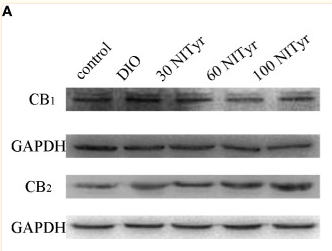CNR2 Antibody - #DF8646
| Product: | CNR2 Antibody |
| Catalog: | DF8646 |
| Description: | Rabbit polyclonal antibody to CNR2 |
| Application: | WB IHC IF/ICC |
| Cited expt.: | WB, IF/ICC |
| Reactivity: | Human, Mouse |
| Prediction: | Pig, Bovine, Horse, Sheep, Dog |
| Mol.Wt.: | 39 kDa; 40kD(Calculated). |
| Uniprot: | P34972 |
| RRID: | AB_2841850 |
Related Downloads
Protocols
Product Info
*The optimal dilutions should be determined by the end user. For optimal experimental results, antibody reuse is not recommended.
*Tips:
WB: For western blot detection of denatured protein samples. IHC: For immunohistochemical detection of paraffin sections (IHC-p) or frozen sections (IHC-f) of tissue samples. IF/ICC: For immunofluorescence detection of cell samples. ELISA(peptide): For ELISA detection of antigenic peptide.
Cite Format: Affinity Biosciences Cat# DF8646, RRID:AB_2841850.
Fold/Unfold
Cannabinoid receptor 2; Cannabinoid receptor 2 macrophage; CB 2; CB-2; CB2; CNR2; CNR2_HUMAN; CNRII; CX 5; CX5; hCB2; testis-dominant CNR2 isoform CB2;
Immunogens
A synthesized peptide derived from human CNR2, corresponding to a region within C-terminal amino acids.
Preferentially expressed in cells of the immune system with higher expression in B-cells and NK cells (at protein level). Expressed in skin in suprabasal layers and hair follicles (at protein level). Highly expressed in tonsil and to a lower extent in spleen, peripheral blood mononuclear cells, and thymus. PubMed:14657172 could not detect expression in normal brain. Expressed in brain by perivascular microglial cells and dorsal root ganglion sensory neurons (at protein level). Two isoforms are produced by alternative promoter usage and differ only in the 5' UTR: isoform CB2A is observed predominantly in testis with some expression in brain, while isoform CB2B is predominant in spleen and leukocytes.
- P34972 CNR2_HUMAN:
- Protein BLAST With
- NCBI/
- ExPASy/
- Uniprot
MEECWVTEIANGSKDGLDSNPMKDYMILSGPQKTAVAVLCTLLGLLSALENVAVLYLILSSHQLRRKPSYLFIGSLAGADFLASVVFACSFVNFHVFHGVDSKAVFLLKIGSVTMTFTASVGSLLLTAIDRYLCLRYPPSYKALLTRGRALVTLGIMWVLSALVSYLPLMGWTCCPRPCSELFPLIPNDYLLSWLLFIAFLFSGIIYTYGHVLWKAHQHVASLSGHQDRQVPGMARMRLDVRLAKTLGLVLAVLLICWFPVLALMAHSLATTLSDQVKKAFAFCSMLCLINSMVNPVIYALRSGEIRSSAHHCLAHWKKCVRGLGSEAKEEAPRSSVTETEADGKITPWPDSRDLDLSDC
Predictions
Score>80(red) has high confidence and is suggested to be used for WB detection. *The prediction model is mainly based on the alignment of immunogen sequences, the results are for reference only, not as the basis of quality assurance.
High(score>80) Medium(80>score>50) Low(score<50) No confidence
Research Backgrounds
Heterotrimeric G protein-coupled receptor for endocannabinoid 2-arachidonoylglycerol mediating inhibition of adenylate cyclase. May function in inflammatory response, nociceptive transmission and bone homeostasis.
Constitutively phosphorylated on Ser-352; phosphorylation increases cell internalization and desensitizes the receptor.
Cell membrane>Multi-pass membrane protein. Cell projection>Dendrite. Perikaryon.
Note: Localizes to apical dendrite of pyramidal neurons.
Preferentially expressed in cells of the immune system with higher expression in B-cells and NK cells (at protein level). Expressed in skin in suprabasal layers and hair follicles (at protein level). Highly expressed in tonsil and to a lower extent in spleen, peripheral blood mononuclear cells, and thymus.could not detect expression in normal brain. Expressed in brain by perivascular microglial cells and dorsal root ganglion sensory neurons (at protein level). Two isoforms are produced by alternative promoter usage and differ only in the 5' UTR: isoform CB2A is observed predominantly in testis with some expression in brain, while isoform CB2B is predominant in spleen and leukocytes.
Belongs to the G-protein coupled receptor 1 family.
Research Fields
· Environmental Information Processing > Signaling molecules and interaction > Neuroactive ligand-receptor interaction.
References
Application: WB Species: Mouse Sample:
Application: IF/ICC Species: Mouse Sample:
Application: WB Species: mice Sample: bone tissue
Application: IF/ICC Species: mice Sample: bone tissue
Application: WB Species: Mouse Sample: brain
Restrictive clause
Affinity Biosciences tests all products strictly. Citations are provided as a resource for additional applications that have not been validated by Affinity Biosciences. Please choose the appropriate format for each application and consult Materials and Methods sections for additional details about the use of any product in these publications.
For Research Use Only.
Not for use in diagnostic or therapeutic procedures. Not for resale. Not for distribution without written consent. Affinity Biosciences will not be held responsible for patent infringement or other violations that may occur with the use of our products. Affinity Biosciences, Affinity Biosciences Logo and all other trademarks are the property of Affinity Biosciences LTD.








